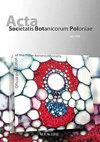Factors determining the variability of the size of generative reproduction organs and leaves of Cytisus scoparius (L.) Link in western Poland
IF 0.8
4区 生物学
Q3 PLANT SCIENCES
引用次数: 0
Abstract
Common broom Cytisus scoparius (L.) Link is a native shrub, common both in Europe and Poland and in many other areas of the world, it is considered an invasive plant. e size of the organs of generative reproduction and the factors determining it are still poorly understood. The study of the size of broom flowers, fruits, seeds and leaves was carried out on 16 plots in western Poland. Habitats were described using Ellenberg’s index values, which allowed us to divide the study into two types: warm, rich in nitrogen, and moister with higher pH. It has been shown that a significant part of the variability in the size of flowers and their elements is conditioned by inter-individual differences. Some features (wings and keel area, number of seeds, or nitrogen content in stems) are also dependent on the type of habitat. Probably the key factor influencing the size of generative organs and the number of seeds is the availability of water in the environment. In more moist habitats and with a higher pH, the organs of generative reproduction are larger, and the nitrogen content is lower. The size of individual elements of the perianth is significantly correlated with each other, and the number of seeds depends on the size of the keel. Depending on environmental factors, the size of the generative organs may affect the efficiency of pollination, which in turn determines the size and number of seeds. The ability of C. scoparius to adapt to various edaphic conditions, the ability to establish symbiosis with atmospheric nitrogen-fixing bacteria, and the production of size-diverse flowers that can be pollinated by insects of various sizes determine its invasive success.决定波兰西部苏铁(Cytisus scoparius (L.) Link)生殖器官和叶片大小变化的因素
普通扫帚 Cytisus scoparius (L.) Link 是一种原生灌木,在欧洲和波兰以及世界许多其他地区都很常见,被认为是一种入侵植物。e 生殖器官的大小及其决定因素仍然鲜为人知。对扫帚花、果实、种子和叶片大小的研究是在波兰西部的 16 块土地上进行的。我们使用艾伦伯格指数值对栖息地进行了描述,从而将研究分为两种类型:温暖、富含氮和湿润、pH 值较高。研究表明,花朵大小及其元素的变化有很大一部分受个体间差异的影响。某些特征(翅和龙骨面积、种子数量或茎中的含氮量)还取决于栖息地的类型。影响生殖器官大小和种子数量的关键因素可能是环境中是否有水。在较潮湿和 pH 值较高的生境中,生殖器官较大,含氮量较低。花被单个元素的大小相互之间有明显的相关性,种子的数量取决于龙骨的大小。根据环境因素的不同,生殖器官的大小可能会影响授粉效率,进而决定种子的大小和数量。莨菪适应各种土壤条件的能力、与大气固氮菌建立共生关系的能力,以及开出大小不一的花朵供不同大小的昆虫授粉的能力,决定了其入侵的成功与否。
本文章由计算机程序翻译,如有差异,请以英文原文为准。
求助全文
约1分钟内获得全文
求助全文
来源期刊
CiteScore
2.00
自引率
10.00%
发文量
18
审稿时长
1 months
期刊介绍:
The journal has been published since 1923 and offers Open Access publication of original research papers, short communications, and reviews in all areas of plant science, including evolution, ecology, genetics, plant structure and development, physiology and biochemistry.

 求助内容:
求助内容: 应助结果提醒方式:
应助结果提醒方式:


